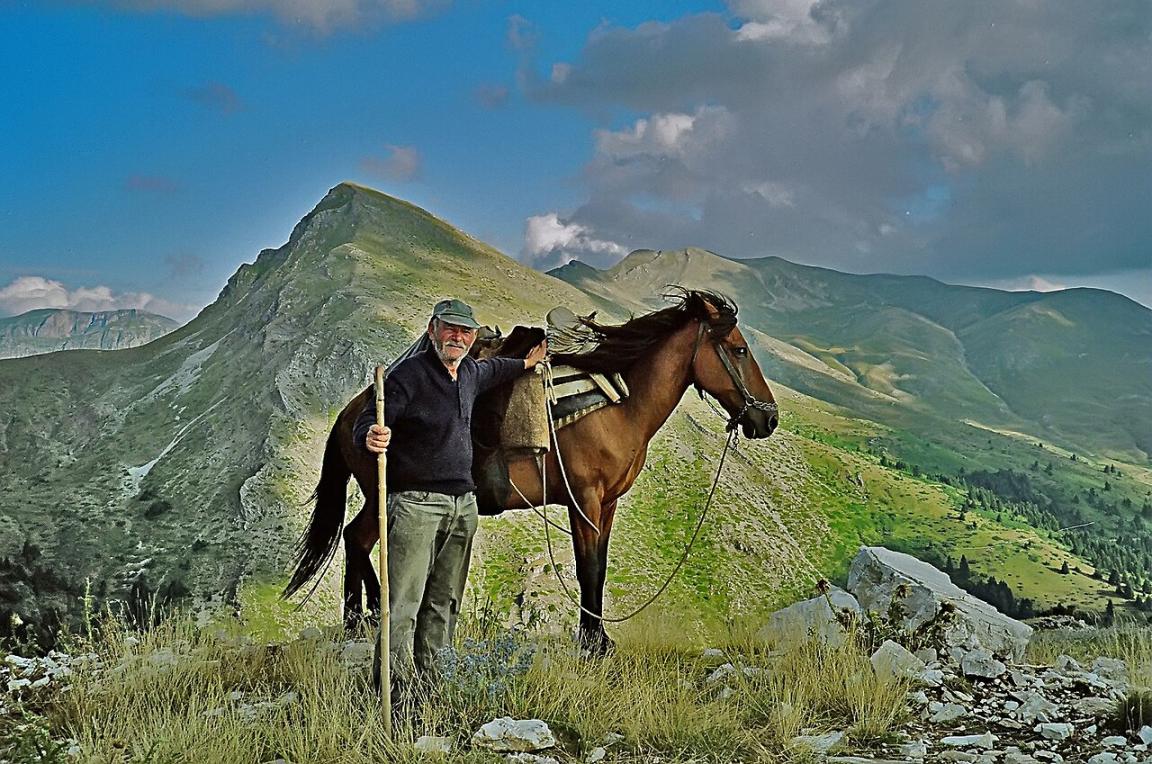
Continent:
Country: Greece
Weight: 200 – 300 kg
Height: 114 – 132 cm
The Pindos Pony originates from the Pindus mountains, a range that crosses western Greece, particularly in Thessaly and Epirus.
This region, marked by its steep relief and harsh climate, shaped a pony that is hardy, frugal, and enduring, perfectly adapted to mountainous conditions. Descended from the ancient Thessalian horses, it belongs to a long pastoral and agricultural tradition, once serving as a riding pony, pack animal, and work companion in isolated rural areas.
The Pindos Pony is closely linked to the Pindus mountain chain, stretching from north to south of Greece, west of Thessaly and Epirus. It is within these rugged landscapes, with forests and alpine pastures, that the breed has developed over centuries.
Breeding centers are mainly found in:
Pindos ponies live most of the year in semi-liberty in the mountains, adapting to a harsh, resource-poor environment. This traditional system favors natural selection, ensuring animals that are robust, frugal, and resistant to the mountain climate.
The breed remains concentrated in northern and central-western rural Greece, with little export. It is sometimes integrated into mountain tourism (trekking, light harness work).
It is one of the few remaining indigenous Greek horse breeds, alongside the Cretan Horse and the Thessalian. It preserves a genetic heritage adapted to Mediterranean mountain environments, forged by centuries of natural selection.
Pindos mares were renowned for producing strong and enduring mules, once highly valued for agriculture and transport. This role as a mule mother breed is part of its historical genetic value.
The Pindos Pony traces back to ancient Greek horse populations, particularly those of Thessaly and Epirus. These ponies descended from small, hardy mountain horses used by Greeks for warfare, travel, and farm work. In mythology and ancient art, Thessalian riders are often depicted on sturdy, agile little horses, resembling the Pindos.
From the Middle Ages to the 19th century, these ponies were indispensable in isolated mountainous regions. They served as pack animals, transporting wood, food, and materials across steep paths where larger horses could not adapt. Their endurance and frugality made them a vital asset for pastoral communities.
Although the Pindos has kept a primitive and hardy type, it was occasionally crossed with oriental horses (notably Arabians) brought through trade and invasions in the Balkans. However, its geographical isolation in the Pindus mountains largely preserved its original identity.
In the 20th century, the mechanization of agriculture and the decline of pastoral life drastically reduced its economic role. The Pindos shifted from an indispensable working animal to a threatened breed. In the 1990s, conservation initiatives began, including its listing in the FAO DAD-IS database as a genetic resource to protect.
Today, the Pindos Pony symbolizes resilience and Greek pastoral culture. It is valued in rural tourism and conservation programs, representing a living link between ancient heritage and modern Greece.
The Pindos Pony is above all a hardy mountain equid, accustomed to surviving in resource-poor environments. This life in semi-liberty in steep pastures has shaped a temperament that is independent and enduring, able to move easily across difficult terrain.
Not demanding in food and resistant to bad weather, it is frugal and well adapted to an extensive lifestyle. This sobriety goes hand in hand with a generally calm character, though sometimes reserved with humans.
Despite its independence, the Pindos is known to be docile and loyal to its owner when treated well. Its small size and balanced temperament make it suitable for children and beginners, particularly in tourism activities.
Accustomed to harsh conditions, it remains vigilant, attentive, and alert. Like many ponies, it can sometimes be stubborn, but it is not aggressive.
The Pindos Pony is considered a threatened local breed, due to the decline of traditional pastoralism in Greece. Current efforts aim to preserve this genetic heritage, recognized for its hardiness and adaptation to harsh environments. Conservation programs are carried out under the Greek Ministry of Agriculture and listed by the FAO (DAD-IS).
A growing trend is the promotion of the Pindos in equestrian tourism activities, such as mountain trekking, nature circuits, and light harness work for visitors. Its small size and endurance make it suitable for a wide audience, including children.
Thanks to its frugality, robustness, and longevity, the Pindos represents a genetic resource for strengthening other hardy pony breeds or maintaining Greek equine biodiversity. In the long term, it could play a role in crossbreeding programs to improve the resistance of small equids.
The main challenge remains the declining herd size and economic disinterest linked to agricultural modernization. Without institutional support, the breed risks a significant decrease. Local associations therefore seek to promote its image and raise awareness among breeders and the public about its cultural and ecological importance.
The Pindos Pony is renowned for its remarkable hardiness, inherited from millennia of adaptation to the difficult conditions of the Pindus mountains (Greece).
It tolerates harsh climates well: cold, snowy winters and dry, resource-poor summers.
The Pindos is recognized for its longevity and can remain fit for work or riding well beyond 20 years.
Fertility is generally good, even under extensive breeding conditions, which has helped the breed survive despite its small population size.